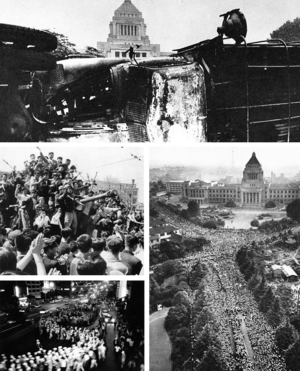Quiet Revolution
| Quiet Revolution | |||||||
|---|---|---|---|---|---|---|---|
 Clockwise, from top: An overturned truck in front of the Sanese Diet, protesters outside the Sanese Diet, protesters blocking Sumida Avenue, Yoshimizu Ohno standing on top of a tank. |
|||||||
|
|||||||
| Belligerents | |||||||
Supported by: |
|||||||
| Commanders and leaders | |||||||
The Quiet Revolution (静かな公転 Shizukana Kōten) was a series of popular demonstrations in Okaiken that began in 1967 and culminated in 1968. The methods used amounted to a sustained campaign of civil resistance against regime violence, economic setbacks and electoral fraud. This case of nonviolent revolution led to the departure of both Emperor Wakayama and the Socialist Prime Minister Kusaka Genzui and also culminated in the dissolution of the Mitoyagi Empire. It is also referred to as the Red Revolution due to the presence of red ribbons and banners during the demonstrations. It was widely seen as a victory of the people against the 10-year rule of the Socialist Party and made news headlines as "the revolution that surprised the world".
The majority of the demonstrations took place in front of Diet of Okaiken in Okami from June 1–6, 1968 and involved over two million Sanese civilians as well as several political and military groups, headed by Republican Party leader Yoshimizu Ohno. The protests, fueled by the resistance and opposition from years of corrupt governance by the Socialist Party, culminated with the resignation of the entire cabinet.